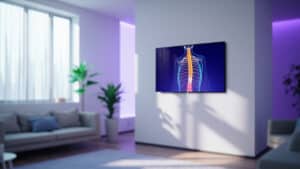What Is Cervical Degenerative Disc Disease? The Answer Might Surprise You
Written by Dr. Matthias Wiederholz, MD – Quadruple Board Certified in Spine & Regenerative Medicine
Quick Insights
Cervical degenerative disc disease is a condition where the neck discs wear down, reducing cushioning between vertebrae. This breakdown triggers pain, impacts movement, and deserves urgent attention to prevent lasting nerve problems—especially in active individuals.
Key Takeaways
- Disc degeneration can cause neck stiffness, tingling, and weakness, often disrupting daily activities and sports for active adults.
- Studies show chronic cervical disc issues may develop as early as your 30s or 40s, not just with age.
- Poor posture can increase stress on cervical discs, potentially harming spinal stability over time.
- Early, personalized treatments—including advanced non-surgical therapies—help restore function and minimize risk of needing spinal fusion.
Why It Matters
Unchecked cervical degenerative disc disease can threaten your independence and favorite activities, leading to pain, missed adventures, and potential nerve damage. Understanding the condition early empowers you to seek care and reclaim movement—without sacrificing the active life you love.
As a quadruple board-certified interventional pain and regenerative medicine specialist, I bring extensive expertise to cervical degenerative disc disease, combining advanced minimally invasive solutions with deep concern for how chronic neck pain affects your active life. Learn more about Dr. Matthias Wiederholz, MD.
Cervical degenerative disc disease is the breakdown of one or more discs in the neck, which act as natural shock absorbers between vertebrae. What is cervical degenerative disc disease? It’s the gradual loss of disc height and cushioning—leading to pain, stiffness, reduced mobility, and, for many, frustration at being sidelined from favorite activities or sports in Houston.
I’ve seen firsthand how neck disc degeneration can disrupt daily routines and emotional well-being. Recent clinical trials have demonstrated that early identification and timely intervention can significantly improve both immediate and long-term outcomes for patients, helping them stay engaged in what they love.
If you’re tired of missing out, the journey to reclaiming movement and comfort begins right here—with options that don’t require major surgery.
Learn more about non-surgical solutions for neck pain.
What Is Cervical Degenerative Disc Disease?
Cervical degenerative disc disease (DDD) is the progressive breakdown of the discs in your neck, which serve as natural shock absorbers between the vertebrae. As these discs lose hydration and height, they become less effective at cushioning the spine, leading to pain and reduced mobility.
What causes cervical degenerative disc disease?
Cervical DDD results from a combination of natural aging, repetitive stress, and sometimes minor injuries. Unlike normal aging, which may not cause symptoms, DDD in the neck can trigger chronic pain, stiffness, and nerve irritation that disrupts daily life.
Degeneration vs. Normal Aging
It’s important to distinguish between normal disc aging and true degenerative disc disease. While everyone’s discs lose some water content over time, DDD involves structural changes—like annular tears or disc bulges—that can compress nerves and cause symptoms. In my practice, I often see active adults develop DDD in their 30s or 40s, not just later in life.
Studies have observed that patients with cervical disc herniation or degenerative spondylosis experience measurable clinical outcomes, suggesting differences between simple aging and disease progression in randomized trials.
If you’re noticing persistent neck pain or stiffness, it’s not just “getting older”—it may be time to seek a specialist’s opinion.
As a quadruple board-certified regenerative medicine specialist, I’ve observed that even younger, athletic adults can struggle with symptom-producing DDD well before traditional retirement age. Early awareness opens the door to proactive, life-restoring options.
Discover expert insights into symptoms of bulging disc in neck C5-C6.

Symptoms of Cervical Degenerative Disc Disease
Cervical DDD can present with a range of symptoms, often affecting your ability to stay active. The most common symptoms include:
- Persistent neck pain or stiffness
- Pain that radiates to the shoulders, arms, or hands
- Tingling, numbness, or weakness in the arms
- Headaches, especially at the base of the skull
- Reduced neck mobility or “locking” sensations
These symptoms can fluctuate, sometimes worsening with activity or certain movements. Having personally performed over 10,000 regenerative spine procedures, I’ve consistently witnessed that truly restoring function and alleviating chronic pain involves not just clinical excellence, but a deep emotional and functional understanding of each patient’s needs. In my experience, patients often describe being unable to enjoy sports, exercise, or even simple daily tasks due to these limitations.
Research shows that symptom profiles for cervical DDD are highly variable, but nerve-related symptoms—like tingling or weakness—should never be ignored as highlighted in neurology research.
Check out our in-depth guide to spinal disc tears, causes, symptoms, and treatment options.
When to Seek Medical Attention
See a physician immediately if you experience:
- Sudden arm or leg weakness
- Loss of bladder or bowel control
- Severe, unrelenting neck pain
Prompt evaluation can prevent permanent nerve damage and restore function.
In my practice, I frequently encounter patients who delayed care, not realizing that progressive nerve-related symptoms can lead to long-term deficits if untreated. Don’t wait for “red flag” warning signs before reaching out for evaluation—early intervention can make all the difference.
Learn about emergency symptoms of a herniated disc.
Causes & Risk Factors
Cervical disc degeneration is influenced by several factors beyond just age. Genetics, lifestyle, and repetitive stress all play a role in how quickly discs break down.
- Family history of spine problems
- Poor posture (especially with prolonged device use)
- Repetitive neck movements or heavy lifting
- Previous neck injuries, even minor ones
- Smoking, which reduces disc nutrition
Lifestyle and Genetic Factors
I’ve seen that active individuals—especially those in sports or physically demanding jobs—may develop DDD earlier due to repetitive microtrauma. Genetics can also predispose you to faster disc degeneration, even if you lead a healthy lifestyle.
Understanding your personal risk factors helps guide prevention and early intervention.
In my assessment, identifying these influences early allows us to personalize your care pathway and prioritize spine health strategies that directly fit your activity level, life demands, and unique anatomy.
Explore managing lumbar degenerative disc disease and prevention.

How Degenerative Disc Disease Is Diagnosed
Diagnosing cervical DDD starts with a detailed history and physical exam. I focus on your symptoms, activity level, and any prior injuries. If DDD is suspected, I use advanced imaging to confirm the diagnosis and rule out other causes.
- X-rays show disc height loss and bone changes.
- MRI reveals disc hydration, annular tears, and nerve compression.
- CT scans may be used for detailed bone assessment.
Modern Imaging and Diagnostics
MRI is the gold standard for evaluating disc health and nerve involvement. In my practice, I rely on high-resolution imaging to pinpoint the exact source of pain, which is critical for planning targeted, minimally invasive treatments.
Recent research emphasizes that precise diagnostics are key to effective, evidence-based therapies in spine care according to the AO Foundation’s latest reports.
As a direct trainee of Dr. Kevin Pauza—the inventor of the Discseel® Procedure—I ensure every diagnostic step lays the groundwork for solutions that genuinely resolve, not just mask, your neck pain.
Learn more about annular tear of lumbar disc diagnosis and care.
Treatment Options for Cervical DDD
What are the best ways to treat cervical degenerative disc disease?
Modern treatment of cervical DDD follows a progressive, personalized approach, starting with conservative care and, if needed, advancing to precision, minimally invasive interventions.
Featured Snippet:
Most people with cervical DDD improve with:
- Physical therapy (to improve strength, posture, mobility)
- Medications (NSAIDs, muscle relaxants)
- Activity modifications (gentle adjustments to daily routines)
- Injections (corticosteroids or regenerative therapies)
If these approaches aren’t enough, next-generation procedures—like Discseel®—can repair the disc itself with minimal downtime.
In my experience, tailoring these steps to each patient results in faster recovery and a higher likelihood of returning to activities you love without repeated setbacks.
- Physical therapy: Restore muscle support and train safe mechanics.
- Medications: Short-term use for pain and inflammation relief.
- Lifestyle modifications: Ergonomic adjustments and posture coaching.
- Injection therapies: Steroid or biologic agents to reduce inflammation or jumpstart healing.
Recently, oxygen-ozone therapy and other minimally invasive procedures have shown impressive clinical success, with outcome rates between 78–93% for relieving disc-related neck pain in multicenter studies.
Clinical guidelines recommend a “stepped-care” model—start conservatively, then escalate only if pain persists as outlined by international experts.
As a specialist, matching the right intervention to the exact source of your pain makes all the difference. I prioritize non-surgical modalities to help you reclaim everyday freedom alongside outstanding long-term relief.
Ready to move beyond pain? See if you’re a candidate for the advanced Discseel® Procedure—schedule your consult today.
Explore effective treatment options for L5-S1 disc herniation pain.

The Discseel® Difference
Discseel® is a cutting-edge, non-surgical procedure that uses a biologic fibrin sealant to repair damaged cervical discs and stimulate natural collagen healing. Unlike traditional spinal fusion, Discseel® preserves motion and eliminates the need for hardware, large incisions, or lengthy hospital stays.
How does Discseel® work?
I inject a uniquely formulated fibrin sealant directly into the affected disc, sealing internal tears (annular tears) and supporting the body’s own regenerative process. Most patients walk out the same day, and many return to basic activities within days—not weeks or months.
How Discseel® Works
As one of only a handful of Master Instructors for Discseel® in the world, directly mentored by Dr. Kevin Pauza, I’ve seen firsthand how this approach halts disc inflammation at the root cause. Many of my patients, who thought surgery or fusion was inevitable, regained their independence and activity levels through Discseel®.
Cutting-edge research now highlights the effectiveness of interventional approaches like this for rapid recovery and sustained improvement in disc-related neck pain according to new peer-reviewed studies.
Read more: Discseel® reviews—achieving lasting back pain relief
Advantages Over Spinal Fusion
- No incisions or metal hardware required
- Preservation of natural neck movement (no fusion loss)
- Success rate of 82%, consistently higher than fusion’s average of 31%
- Outpatient; minimal downtime so you return to life faster
Ongoing research in engineering and regenerative medicine is exploring the potential of biologic repair as an alternative to traditional fusion surgery. For patients, this means less risk, more natural function, and a higher chance of long-term relief as summarized in engineering outcome studies.
Unlike larger clinics where patients may rarely see the same provider, I personally oversee every Discseel® case from consultation to recovery. This ensures not only technical success, but lasting function and confidence as you return to your passions.
See our comprehensive guide to L5-S1 bulging disc.
Why Trust Dr. Wiederholz and Performance Pain & Sports Medicine?
Choosing the right specialist shapes every stage of your experience and recovery. My quadruple board certifications—and direct Discseel® training from the inventor—mean you receive care at the absolute forefront of regenerative spine medicine.
Board-Certified Expertise
With over 10,000 minimally invasive procedures completed, I tailor every aspect of your treatment plan to your personal goals, anatomy, and activity level. At my boutique practices in Houston, TX and Lawrenceville, NJ, patients experience attentive, hands-on care—not just a brief visit with an anonymous provider.
Innovations in disc degeneration research routinely shape my methods, ensuring you benefit from the latest science and successes—a commitment I uphold at every visit as recommended in recent AO Foundation guidance.
Professional Assessment:
As a regenerative spine specialist, I see daily that combining advanced diagnostics, personalized communication, and leading-edge procedures—like Discseel®—provides outcomes that truly surpass “standard” neck care.

Patient Success Stories: What Our Patients Say on Google
Patient experiences are at the heart of my approach to treating cervical degenerative disc disease. Every individual’s journey is unique, and I value the trust patients place in me to guide them through advanced, non-surgical solutions.
I recently received feedback that captures what we aim to provide for every patient—personalized care, clear communication, and a commitment to the most effective, least invasive options. This reviewer shared:
“I would highly recommend Dr. Wiederholz. I have known him for years. He is a smart and caring doctor. He truly takes his time with you during your appointment to listen to your concerns and talk out all options. He is always researching and learning the newest and best ways to alleviate pain in the most conservative way possible. I recently had a disc seel procedure done on my L4-5. My post procedure experience was just as he explained it. He and his office were really good about following up with me on how I was doing. He was quick to respond to any questions I had before and after my procedure. I will continue to follow up with him as I navigate this process and know that I am in good hands.”
— Carrie
Hearing this kind of feedback reinforces my dedication to providing evidence-based, compassionate care for those facing cervical disc degeneration. Your trust and outcomes drive every decision I make in the clinic.
Read more about L5-S1 herniated disc surgery overview.

Houston’s Resource for Non-Surgical Neck Pain Relief
If you’re seeking a cervical DDD specialist in Houston dedicated to pioneering non-surgical solutions, you’ve found the right place. At Performance Pain & Sports Medicine, we serve active patients across Greater Houston and beyond, offering:
- The latest minimally invasive cervical disc treatments
- Concierge-style, empathetic care and follow-through
- Rapid access to imaging, procedures, and rehabilitation
- Board-certified expertise that puts your goals first
Whether you’re an athlete, a weekend warrior, or simply want to keep up with kids or grandkids, we’ll help you restore your neck health and mobility—without major surgery or long recovery times.
Thinking about options in New Jersey? Our Lawrenceville location is equally committed to DDD relief backed by world-class regenerative spine expertise.
Cervical Degenerative Disc Disease Care in Houston, TX
Living in Houston, TX means you’re part of a vibrant, active community—and neck pain shouldn’t keep you from enjoying all the city has to offer. The demands of Houston’s fast-paced lifestyle, combined with long commutes and time spent at desks or on devices, can contribute to cervical disc degeneration for many residents.
At Performance Pain & Sports Medicine, I see a wide range of patients—from athletes training in Memorial Park to professionals working downtown—who want to stay active without resorting to major surgery. Our Houston clinic is equipped with advanced imaging and minimally invasive treatment options, including the Discseel® Procedure, to address cervical DDD at its source.
We’re committed to serving the Greater Houston area with personalized, concierge-style care and rapid access to diagnostics and therapies. Whether you’re struggling with neck stiffness, nerve symptoms, or have been told surgery is your only option, you’ll find innovative solutions right here in Houston.
If you’re ready to explore non-surgical relief for cervical degenerative disc disease, schedule a consultation at our Houston office and take the first step toward reclaiming your mobility and comfort.
Conclusion
Cervical degenerative disc disease can disrupt your life, but you don’t have to accept pain or lost mobility as your new normal. My approach centers on restoring your function and confidence—using advanced regenerative care, without invasive surgery. Treatments like Discseel® help you reclaim activities you love, while my boutique practice ensures you receive attentive, personalized care every step of the way. Current research supports these innovative therapies for long-term relief and improved quality of life.
As a quadruple board-certified regenerative spine specialist, I invite you to stop missing out on family events or daily activities due to neck pain. See if you are a candidate for the Discseel® Procedure—schedule your consult today. Early intervention leads to better outcomes. Let’s help you reclaim your life.
This article is for educational purposes only and should not be used as a substitute for professional medical advice, diagnosis, or treatment. Always seek the advice of your physician or other qualified healthcare provider with any questions you may have regarding a medical condition or treatment options. Never disregard professional medical advice or delay in seeking it because of something you have read in this article.
Frequently Asked Questions
What is cervical degenerative disc disease and how does it affect daily life?
Cervical degenerative disc disease is the breakdown of neck discs, leading to pain, stiffness, and sometimes nerve symptoms like tingling or weakness. This condition can make it difficult to stay active, work, or enjoy hobbies. Many patients notice limitations in movement or discomfort during daily activities, but early, targeted treatment can help restore function and comfort.
Where can I find a cervical DDD specialist in Houston, TX?
You can find a cervical DDD specialist in Houston at my practice, Performance Pain & Sports Medicine. I offer advanced, non-surgical treatments—including Discseel®—with prompt appointments and personalized care. My Houston office is dedicated to helping active individuals regain mobility and return to the activities they love, without major surgery or long recovery times.
As an active adult, what are my options if I want to avoid spinal fusion?
If you want to avoid spinal fusion, I recommend starting with conservative therapies like physical therapy and targeted injections. If those aren’t enough, minimally invasive procedures such as Discseel® can repair damaged discs and preserve your natural movement. These options are supported by clinical research and often allow for a faster, more complete return to your active lifestyle.

















